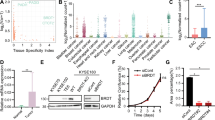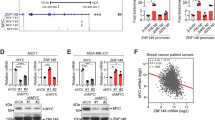Abstract
NUT midline carcinoma (NMC) is an aggressive type of squamous cell carcinoma that is defined by the presence of BRD-NUT fusion oncogenes, which encode chimeric proteins that block differentiation and maintain tumor growth. BRD-NUT oncoproteins contain two bromodomains whose binding to acetylated histones is required for the blockade of differentiation in NMC, but the mechanisms by which BRD-NUT act remain uncertain. Here, we provide evidence that MYC is a key downstream target of BRD4-NUT. Expression profiling of NMCs shows that the set of genes whose expression is maintained by BRD4-NUT is highly enriched for MYC upregulated genes, and MYC and BRD4-NUT protein expression is strongly correlated in primary NMCs. More directly, we find that BRD4-NUT associates with the MYC promoter and is required to maintain MYC expression in NMC cell lines. Moreover, both siRNA knockdown of MYC and a dominant-negative form of MYC, omomyc, induce differentiation of NMC cells. Conversely, differentiation of NMC cells induced by knockdown of BRD4-NUT is abrogated by enforced expression of MYC. Together, these findings suggest that MYC is a downstream target of BRD4-NUT that is required for maintenance of NMC cells in an undifferentiated, proliferative state. Our findings support a model in which dysregulation of MYC by BRD-NUT fusion proteins has a central role in the pathogenesis of NMC.
This is a preview of subscription content, access via your institution
Access options
Subscribe to this journal
Receive 50 print issues and online access
$259.00 per year
only $5.18 per issue
Buy this article
- Purchase on Springer Link
- Instant access to full article PDF
Prices may be subject to local taxes which are calculated during checkout




Similar content being viewed by others
References
Bauer D, Mitchell C, Strait K, Lathan C, Stelow E, Lueer S et al. Clinicopathologic features and long-term outcomes of NUT midline carcinoma. Clin Cancer Res 2012; 18: 5773–5779.
French CA, Miyoshi I, Kubonishi I, Grier HE, Perez-Atayde AR, Fletcher JA . BRD4-NUT fusion oncogene: a novel mechanism in aggressive carcinoma. Cancer Res 2003; 63: 304–307.
French CA, Ramirez CL, Kolmakova J, Hickman TT, Cameron MJ, Thyne ME et al. BRD-NUT oncoproteins: a family of closely related nuclear proteins that block epithelial differentiation and maintain the growth of carcinoma cells. Oncogene 2008; 27: 2237–2242.
Filippakopoulos P, Qi J, Picaud S, Shen Y, Smith WB, Fedorov O et al. Selective inhibition of BET bromodomains. Nature 2010; 468: 1067–1073.
Schwartz BE, Hofer MD, Lemieux ME, Bauer DE, Cameron MJ, West NH et al. Differentiation of NUT midline carcinoma by epigenomic reprogramming. Cancer Res 2011; 71: 2686–2696.
Subramanian A, Tamayo P, Mootha VK, Mukherjee S, Ebert BL, Gillette MA et al. Gene set enrichment analysis: a knowledge-based approach for interpreting genome-wide expression profiles. Proc Natl Acad Sci USA 2005; 102: 15545–15550.
Schuhmacher M, Kohlhuber F, Holzel M, Kaiser C, Burtscher H, Jarsch M et al. The transcriptional program of a human B cell line in response to Myc. Nucleic Acids Res 2001; 29: 397–406.
Yu D, Cozma D, Park A, Thomas-Tikhonenko A . Functional validation of genes implicated in lymphomagenesis: an in vivo selection assay using a Myc-induced B-cell tumor. Ann NYAcad Sci 2005; 1059: 145–159.
Zuber J, Shi J, Wang E, Rappaport AR, Herrmann H, Sison EA et al. RNAi screen identifies Brd4 as a therapeutic target in acute myeloid leukaemia. Nature 2011; 478: 524–528.
Delmore JE, Issa GC, Lemieux ME, Rahl PB, Shi J, Jacobs HM et al. BET bromodomain inhibition as a therapeutic strategy to target c-Myc. Cell 2011; 146: 904–917.
Mertz JA, Conery AR, Bryant BM, Sandy P, Balasubramanian S, Mele DA et al. Targeting MYC dependence in cancer by inhibiting BET bromodomains. Proc Natl Acad Sci USA 2011; 108: 16669–16674.
Lin YJ, Umehara T, Inoue M, Saito K, Kigawa T, Jang MK et al. Solution structure of the extraterminal domain of the bromodomain-containing protein BRD4. Protein Sci 2008; 17: 2174–2179.
Lin CH, Jackson AL, Guo J, Linsley PS, Eisenman RN . Myc-regulated microRNAs attenuate embryonic stem cell differentiation. EMBO J 2009; 28: 3157–3170.
Pelengaris S, Khan M, Evan GI . Suppression of Myc-induced apoptosis in beta cells exposes multiple oncogenic properties of Myc and triggers carcinogenic progression. Cell 2002; 109: 321–334.
Gomez-Casares MT, Garcia-Alegria E, Lopez-Jorge CE, Ferrandiz N, Blanco R, Alvarez S et al. MYC antagonizes the differentiation induced by imatinib in chronic myeloid leukemia cells through downregulation of p27(KIP1). Oncogene 2013; 32: 2239–2246.
Acosta JC, Ferrandiz N, Bretones G, Torrano V, Blanco R, Richard C et al. Myc inhibits p27-induced erythroid differentiation of leukemia cells by repressing erythroid master genes without reversing p27-mediated cell cycle arrest. Mol Cell Biol 2008; 28: 7286–7295.
Varlakhanova NV, Cotterman RF, deVries WN, Morgan J, Donahue LR, Murray S et al. myc maintains embryonic stem cell pluripotency and self-renewal. Differentiation 2010; 80: 9–19.
Field JK, Spandidos DA, Stell PM, Vaughan ED, Evan GI, Moore JP . Elevated expression of the c-myc oncoprotein correlates with poor prognosis in head and neck squamous cell carcinoma. Oncogene 1989; 4: 1463–1468.
Abou-Elella A, Gramlich T, Fritsch C, Gansler T . c-myc amplification in hepatocellular carcinoma predicts unfavorable prognosis. Mod Pathol 1996; 9: 95–98.
Young J, Buttenshaw R, Butterworth L, Ward M, Searle J, Leggett B et al. Association of the SS genotype of the L-myc gene and loss of 18q sequences with a worse clinical prognosis in colorectal cancers. Oncogene 1994; 9: 1053–1056.
Mossafa H, Damotte D, Jenabian A, Delarue R, Vincenneau A, Amouroux I et al. Non-Hodgkin's lymphomas with Burkitt-like cells are associated with c-Myc amplification and poor prognosis. Leuk Lymphoma 2006; 47: 1885–1893.
Akervall J, Bockmuhl U, Petersen I, Yang K, Carey TE, Kurnit DM . The gene ratios c-MYC:cyclin-dependent kinase (CDK)N2A and CCND1:CDKN2A correlate with poor prognosis in squamous cell carcinoma of the head and neck. Clin Cancer Res 2003; 9: 1750–1755.
Savage KJ, Johnson NA, Ben-Neriah S, Connors JM, Sehn LH, Farinha P et al. MYC gene rearrangements are associated with a poor prognosis in diffuse large B-cell lymphoma patients treated with R-CHOP chemotherapy. Blood 2009; 114: 3533–3537.
Barrans S, Crouch S, Smith A, Turner K, Owen R, Patmore R et al. Rearrangement of MYC is associated with poor prognosis in patients with diffuse large B-cell lymphoma treated in the era of rituximab. J Clin Oncol 2010; 28: 3360–3365.
Soucek L, Whitfield J, Martins CP, Finch AJ, Murphy DJ, Sodir NM et al. Modelling Myc inhibition as a cancer therapy. Nature 2008; 455: 679–683.
Soucek L, Jucker R, Panacchia L, Ricordy R, Tato F, Nasi S . Omomyc, a potential Myc dominant negative, enhances Myc-induced apoptosis. Cancer Res 2002; 62: 3507–3510.
Soucek L, Nasi S, Evan GI . Omomyc expression in skin prevents Myc-induced papillomatosis. Cell Death Differ 2004; 11: 1038–1045.
Reynoird N, Schwartz BE, Delvecchio M, Sadoul K, Meyers D, Mukherjee C et al. Oncogenesis by sequestration of CBP/p300 in transcriptionally inactive hyperacetylated chromatin domains. EMBO J 2010; 29: 2943–2952.
Knoepfler PS, Zhang XY, Cheng PF, Gafken PR, McMahon SB, Eisenman RN . Myc influences global chromatin structure. EMBO J 2006; 25: 2723–2734.
Varlakhanova NV, Knoepfler PS . Acting locally and globally: Myc's ever-expanding roles on chromatin. Cancer Res 2009; 69: 7487–7490.
Pellakuru LG, Iwata T, Gurel B, Schultz D, Hicks J, Bethel C et al. Global levels of H3K27me3 track with differentiation in vivo and are deregulated by MYC in prostate cancer. Am J Pathol 2012; 181: 560–569.
Yan J, Diaz J, Jiao J, Wang R, You J . Perturbation of BRD4 protein function by BRD4-NUT protein abrogates cellular differentiation in NUT midline carcinoma. J Biol Chem 2011; 286: 27663–27750.
Murphy DJ, Junttila MR, Pouyet L, Karnezis A, Shchors K, Bui DA et al. Distinct thresholds govern Myc's biological output in vivo. Cancer Cell 2008; 14: 447–457.
Watt FM, Frye M, Benitah SA . MYC in mammalian epidermis: how can an oncogene stimulate differentiation? Nat Rev Cancer 2008; 8: 234–242.
Arnold I, Watt FM . c-Myc activation in transgenic mouse epidermis results in mobilization of stem cells and differentiation of their progeny. Current Biol 2001; 11: 558–568.
Gandarillas A, Watt FM . c-Myc promotes differentiation of human epidermal stem cells. Genes Dev 1997; 11: 2869–2882.
Flores I, Murphy DJ, Swigart LB, Knies U, Evan GI . Defining the temporal requirements for Myc in the progression and maintenance of skin neoplasia. Oncogene 2004; 23: 5923–5930.
Pelengaris S, Littlewood T, Khan M, Elia G, Evan G . Reversible activation of c-Myc in skin: induction of a complex neoplastic phenotype by a single oncogenic lesion. Mol Cell 1999; 3: 565–577.
Subramanian A, Kuehn H, Gould J, Tamayo P, Mesirov JP . GSEA-P: a desktop application for Gene Set Enrichment Analysis. Bioinformatics 2007; 23: 3251–3253.
Kluk MJ, Chapuy B, Sinha P, Roy A, Dal Cin P, Neuberg DS et al. Immunohistochemical detection of MYC-driven diffuse large B-cell lymphomas. PLoS One 2012; 7: e33813.
Haack H, Johnson LA, Fry CJ, Crosby K, Polakiewicz RD, Stelow EB et al. Diagnosis of NUT midline carcinoma using a NUT-specific monoclonal antibody. Am J Surg Pathol 2009; 33: 984–991.
Stelow EB, Bellizzi AM, Taneja K, Mills SE, Legallo RD, Kutok JL et al. NUT rearrangement in undifferentiated carcinomas of the upper aerodigestive tract. Am J Surg Pathol 2008; 32: 828–834.
Toretsky JA, Jenson J, Sun CC, Eskenazi AE, Campbell A, Hunger SP et al. Translocation (11;15;19): a highly specific chromosome rearrangement associated with poorly differentiated thymic carcinoma in young patients. Am J Clin Oncol 2003; 26: 300–306.
Senapedis WT, Kennedy CJ, Boyle PM, Silver PA . Whole genome siRNA cell-based screen links mitochondria to Akt signaling network through uncoupling of electron transport chain. Mol Biol Cell 2011; 22: 1791–1805.
Ince TA, Richardson AL, Bell GW, Saitoh M, Godar S, Karnoub AE et al. Transformation of different human breast epithelial cell types leads to distinct tumor phenotypes. Cancer Cell 2007; 12: 160–170.
Acknowledgements
This work was supported by the Samuel Waxman Cancer Research Foundation (CAF and JEB), the US National Institutes of Health grant 1R01CA124633 (CAF), the Adolescent and Young Adult Gap Fund (CAF and JEB), and the American Association for Cancer Research grant 10-20-03-FREN. We would like to thank Dr Nicholas Haining for assistance with GSEA. Many thanks to Dr Paola Dal Cin for providing fluorescent in situ hybridization probes, and to Mr Dan Shea for his assistance with fluorescent in situ hybridization photomicrographs. High-throughput siRNA assays were performed at the Institute of Chemistry and Cell Biology, Longwood Campus (ICCB-L, http://iccb.med.harvard.edu/).
Author information
Authors and Affiliations
Corresponding author
Ethics declarations
Competing interests
The authors declare no conflict of interest.
Additional information
Supplementary Information accompanies this paper on the Oncogene website
Rights and permissions
About this article
Cite this article
Grayson, A., Walsh, E., Cameron, M. et al. MYC, a downstream target of BRD-NUT, is necessary and sufficient for the blockade of differentiation in NUT midline carcinoma. Oncogene 33, 1736–1742 (2014). https://doi.org/10.1038/onc.2013.126
Received:
Revised:
Accepted:
Published:
Issue Date:
DOI: https://doi.org/10.1038/onc.2013.126
Keywords
This article is cited by
-
Top IHC/ISH Hacks for and Molecular Surrogates of Poorly Differentiated Sinonasal Small Round Cell Tumors
Head and Neck Pathology (2024)
-
Structural mechanism of BRD4-NUT and p300 bipartite interaction in propagating aberrant gene transcription in chromatin in NUT carcinoma
Nature Communications (2023)
-
Clinical and molecular features of pulmonary NUT carcinoma characterizes diverse responses to immunotherapy, with a pathologic complete response case
Journal of Cancer Research and Clinical Oncology (2023)
-
NUT carcinoma of the parotid gland: report of two cases, one with a rare ZNF532-NUTM1 fusion
Virchows Archiv (2022)
-
Supercharging BRD4 with NUT in carcinoma
Oncogene (2021)



